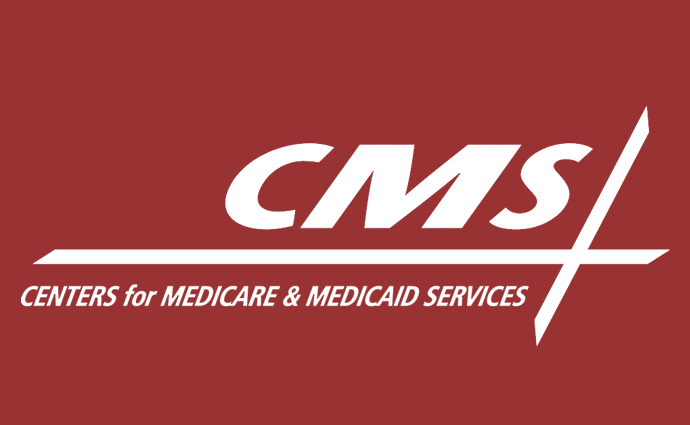CMS Proposes Minimum Staffing Standards for Nursing Homes
The minimum staffing standards would require nursing homes to have a registered nurse onsite at all times to provide direct resident care.

Source: CMS Logo
- CMS has proposed minimum staffing standards for nursing homes, requiring facilities to provide residents with at least three hours of care per day.
The Minimum Staffing Standards for Long-Term Care (LTC) Facilities and Medicaid Institutional Payment Transparency Reporting proposed rule aims to solidify access to safe and high-quality nursing homes, CMS said.
The rule includes three main staffing proposals for nursing homes participating in Medicare and Medicaid.
First, nursing homes must provide each resident with a minimum of 0.55 hours of care per day from a registered nurse and 2.45 hours per day from a nurse aide. However, facilities must also provide staffing that meets the needs of the individual residents they serve, which may require higher staffing levels than the proposed minimum standards.
CMS estimates that 75 percent of nursing homes would have to bolster facility staffing to meet the proposed standards.
READ MORE: Higher Spending on Nursing Home Staff is Not Tied to Better Staffing Levels
Data from KFF found that almost all facilities would meet a requirement of 2.5 or fewer direct care hours per resident day, while 85 percent would meet a requirement of 3.0 hours per resident day.
Second, nursing homes must have a registered nurse onsite 24 hours per day, seven days a week, who can provide direct resident care. This requirement aims to improve care for residents with complex and acute medical conditions requiring significant resources and care from registered nurses.
Third, nursing homes would be required to complete enhanced facility assessments on staffing needs. Currently, LTC facilities are required to conduct, document, and review annually an evaluation to determine the resources they need to care for residents. CMS has proposed updates to the facility assessment.
Proposals include clarifying that facilities must use evidence-based methods when planning care for their residents, requiring facilities to use the assessments to look at the specific needs of each resident, and requiring facilities to include input from all staff.
Given the ongoing staffing shortages resulting from the COVID-19 pandemic, the proposed standards include staggered implementation and exemption processes. LTC facilities may qualify for a temporary hardship exemption from the staffing standards if they demonstrate workforce unavailability based on their location, good faith efforts to hire and retain staff, and a financial commitment to staffing.
READ MORE: GAO: CMS Nursing Home Ownership Information Lacks Transparency
In addition to staffing standards, the proposed rule included provisions to improve Medicaid payment transparency. States would be required to report to CMS on the percentage of Medicaid payments for services in nursing facilities and intermediate care facilities that are spent on compensation for direct care workers and support staff.
Additionally, the rule proposes that states and CMS make the institutional payment information reported by states to CMS available on public-facing websites.
Industry reactions
Nursing home and LTC organizations have voiced their opposition to the final rule.
“It is unfathomable that the Biden Administration is proceeding with this federal staffing mandate proposal. Especially when just days ago, we learned that CMS’ own study found that there is no single staffing level that would guarantee quality care,” Mark Parkinson, CEO of the American Health Care Association (AHCA), said in a statement.
“At the very same time, nursing homes are facing the worst labor shortage in our sector’s history, and seniors’ access to care is under threat. This unfunded mandate, which will cost billions of dollars each year, will worsen this growing crisis.”
READ MORE: Significant Staffing Challenges Continue for Nursing Homes
Katie Smith Sloan, president and CEO of LeadingAge, the association of nonprofit providers of aging services, expressed similar concerns.
“To say that we are disappointed that President Biden chose to move forward with the proposed staffing ratios despite clear evidence against them is an understatement. We share the Administration’s goal of ensuring access to quality nursing home care. This proposed rule works against that shared goal,” Sloan said. “One-size-fits-all staffing ratios don’t guarantee quality, as the Administration’s own research findings made clear. That aside, it’s meaningless to mandate staffing levels that cannot be met.”
Government officials also made their disappointment clear.
“America’s seniors need access to quality care. Rather than helping to serve that goal, today’s proposed rule fails to acknowledge the realities that nursing homes are facing and will harm more seniors than it helps. The rule will put nursing homes—particularly in rural areas—in an impossible dilemma as they grapple with how to manage current occupancy levels with the insufficient workforce available to meet the requirements,” Cathy McMorris Rodgers (R-WA), chair of the House Energy and Commerce Committee, said in a statement.
“This rule fails to adequately balance the needs of seniors and nursing home staff in the face of the current staffing shortage gripping our nation. A one-size-fits-all mandate for nursing homes will not bring the results that the Biden administration hopes to achieve.”
